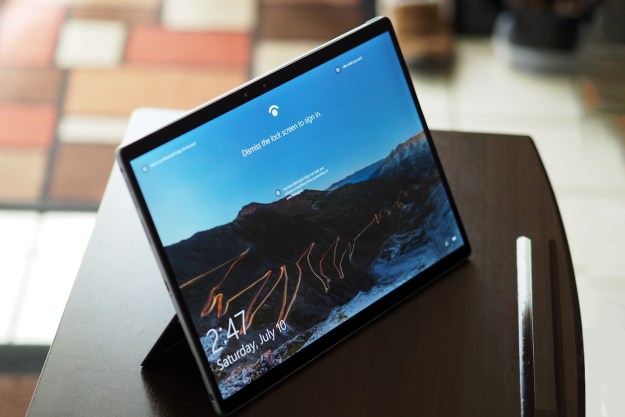
“The Dell Latitude 7320 Detachable is the best Windows tablet for business users.”
- Solid build quality
- Very good display
- Competent productivity performance
- Thin and light
- Good selection of business features
- Expensive
- Keyboard and pen are costly add-ons
- Battery life is less than average
Windows tablets are making a comeback, especially in the business world. Microsoft released its Surface Pro 7+ for business users, and Lenovo released the ThinkPad X12 Detachable. The Lenovo is a particularly formidable competitor, making our list of best 2-in-1s. Now, Dell has jumped into the fray with the Latitude 7320 Detachable, another business-oriented laptop that aims to meet the needs of corporate users.
Dell sent me a $2,189 (retail price $3,127) configuration with an 11th-gen Intel Core i7-1180G7 CPU with vPro support, 16GB of RAM, a 256GB PCIe, solid-state drive (SSD), a 13-inch IPS FHD+ (1920 x 1280) 3:2 display, and the optional keyboard and pen. The detachable tablet has a very particular form, pioneered by the Surface Pro, and the Latitude 7320 Detachable follows that format to the letter. Does it offer enough to stand out in an increasingly crowded field?
Design
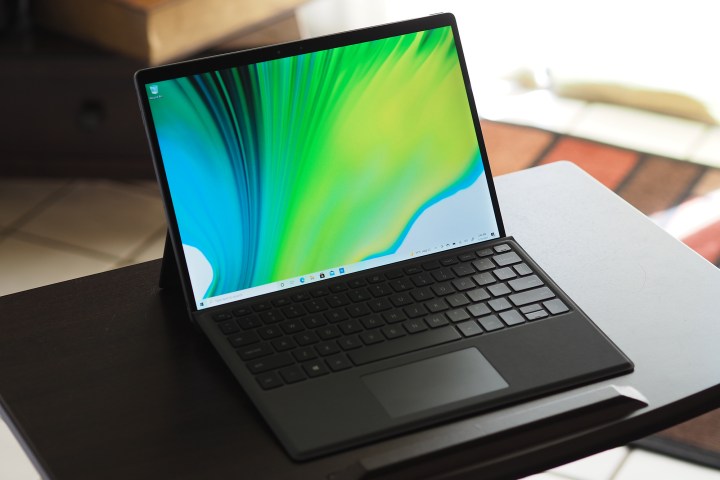
The Latitude 7320 Detachable and the Surface Pro 7+ don’t look exactly alike. They’re similar, but Dell’s aluminum chassis is more rounded along the edges than Microsoft’s magnesium chassis. It’s a darker gray color compared with Microsoft’s brighter silver, and the bezels are smaller along the sides — a huge positive. There’s more similarity with the Surface Pro X, which is also more rounded and enjoys smaller side bezels. The Latitude 7320 Detachable is an attractive device if rather conservatively designed, with few embellishments other than the Dell and Latitude logos on the back of the chassis.
Dell’s and Microsoft’s tablets sport the same kind of kickstand that opens along the back and extends to similar angles, and their detachable keyboards are almost identical (more on that later). I’ll note here that the Latitude 7320 Detachable’s kickstand opens farther down and isn’t as sturdy as the Surface Pro 7+ the more upright you position the tablet. Lenovo’s ThinkPad X12 Detachable also has a similar design although it harnesses the iconic ThinkPad look and feel, with a soft-touch surface compared with the cold metal of the other two and an all-black aesthetic. Interestingly, the Lenovo looks more like the Surface Pro 7+ along the sides, and its kickstand is also better positioned for a more solid feel.
Each of the tablets is remarkably similar in size, with the Latitude 7320 Detachable coming in at 0.33 inches thick and 1.7 pounds (tablet only), compared to the Surface Pro 7+ at 0.33 inches and 1.7 pounds and the ThinkPad X12 Detachable at 0.34 inches and 1.67 pounds. Thanks to the slightly larger 13-inch 3:2 display (compared to the 12.3-inch 3:2 displays on the Microsoft and Lenovo tablets), the Latitude 7320 Detachable is a bit taller. These are all very lightweight and nicely sized tablets, though, and so none has an advantage here.
In terms of durability, the Latitude 7320 Detachable feels almost as robust as its competition, which is saying a lot. Both the Surface Pro 7+ and ThinkPad X12 Detachable are rock-solid machines, and the Dell follows suit — for the most part. The only difference is in the kickstand. Again, Dell’s version is inferior to the other two. It simply doesn’t feel as well-designed as the others, and as mentioned, the tablet doesn’t feel as stable past a certain vertical point.
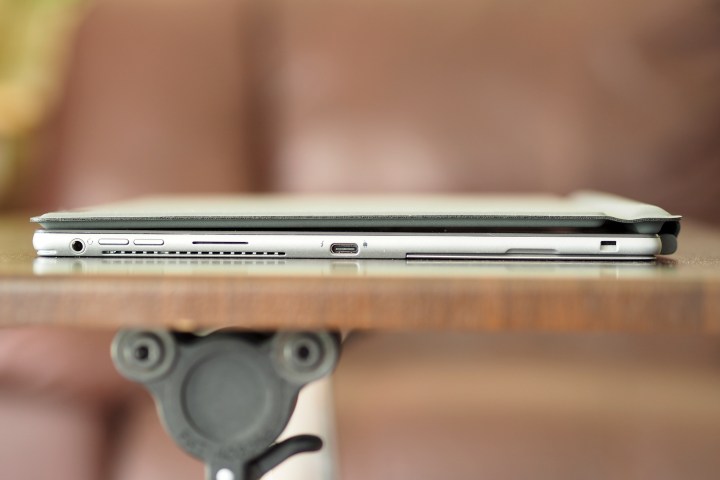
Connectivity is limited to a USB-C port with Thunderbolt 4 support on each side of the tablet and a 3.5mm audio jack at the upper left. If you opt for the optional WWAN LTE 4 support, then you’ll also find a micro-SIM slot on the right side. Wireless connectivity is Wi-Fi 6 and Bluetooth 5.1.
Performance
Dell equipped the Latitude 7320 Detachable with low-power versions of Intel’s 11th-gen Core processors, and my review unit was configured with the Core i7-1180G7 with vPro. This is the first laptop we’ve reviewed with this specific CPU, although we’ve reviewed slower versions. I was expecting the same kind of performance out of the Latitude 7320 Detachable, which is to say, solid productivity performance but not enough power for CPU-intensive creative apps.
Unsurprisingly, that’s exactly what I experienced. In Geekbench 5, for example, the Dell performed a little slower than the Lenovo ThinkPad X1 Nano with the Core i7-1160G7 but faster than the ThinkPad X12 Detachable with its Core i5-1130G7. The HP Spectre x360 14 was slower, but I’m reporting its performance in “optimal” mode and not “performance” mode as set in the HP Command Center utility. That laptop is much faster in performance mode. Speaking of thermal and performance management utilities, the Latitude 7320 Detachable uses Dell’s Power Manager utility, but it made little difference in our benchmarks.
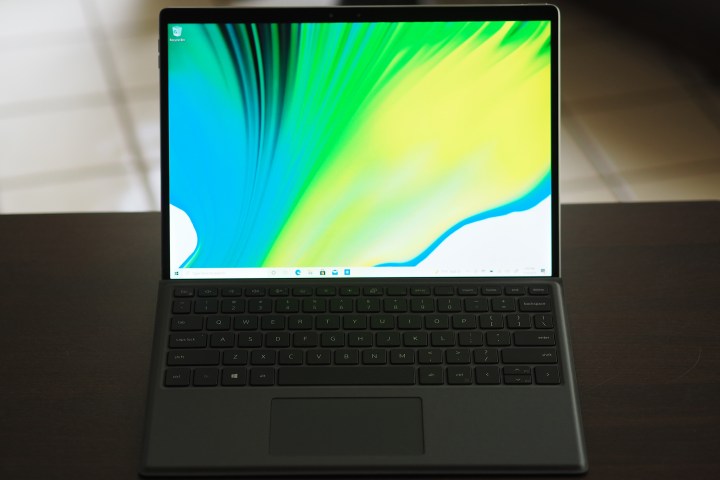
In our Handbrake test, which encodes a 420MB video as H.265, the Latitude 7320 Detachable took last place among our comparison group. Four minutes is rather long in this test for modern CPUs, and while the Spectre x360 14 was also slow, it was much faster in its performance mode. Next up is Cinebench R23, where the Dell again took last place. Clearly, the tablet needs to throttle the CPU to keep things cool in such a thin chassis. Note that I included the Asus ZenBook 13 OLED just to demonstrate how these slower Intel Core machines compare to AMD’s contemporary Ryzen chips.
Finally, I ran the PCMark 10 Complete test, where, as you might imagine, the Latitude 7320 Detachable fell behind. These results carried over to the Essentials, Productivity, and Content Creation portions of the benchmark, with the latter being particularly slow. Interestingly, the Dell Power Manager utility made a bit more of a difference in this test where every other utility I’ve used did not. The difference wasn’t significant, but the Latitude 7320 Detachable was faster than the ThinkPad X12 Detachable and ThinkPad X1 Nano in performance mode.
Overall, as I suspected, the Latitude 7320 Detachable is plenty fast for productivity tasks, which we can say for every modern laptop we’ve reviewed. You won’t notice any slowdowns or lagging when you’re running your web browser, Office apps, and the like, but try to do anything that’s CPU-intensive and you’ll be disappointed. The tablet also stayed cool to the touch, with quiet and unobtrusive fans that spun up when it was working hard. We reviewed the Surface Pro 7 long before switching our benchmark tests, and so I can’t do a direct comparison. The Surface Pro 7+ uses full-speed 11th-gen Intel Core CPUs, and so it’s likely to be faster than the Dell.
| Geekbench (single/multi) | Handbrake (seconds) | Cinebench R23 (single/multi) | PCMark 10 | 3DMark Time Spy | |
| Dell Latitude 7320 Detachable (Core i7-1180G7) |
1532/5031 | 247 | 1246/3339 | 4410 | 1443 |
| Lenovo ThinkPad X12 Detachable (Core i5-1130G7) | 1352/4796 | 185 | 1125/3663 | 4443 | 926 |
| Lenovo ThinkPad X1 Nano (Core i7-1160G7) |
1466/5139 | 180 | 1377/4550 | 4600 | 1549 |
| HP Spectre x360 14 (Core i7-1165G7) |
1214/4117 | 236 | 1389/3941 | 4728 | 1457 |
| Asus ZenBook 13 OLED (AMD Ryzen 7 5800U) |
1423 / 6758 | 124 | 1171 / 7824 | 6034 | 1342 |
I ran Fortnite on the Latitude 7320 Detachable to see how well the tablet can game, and long story short, it can’t. It managed just 14 frames per second (fps) at 1080p and high graphics and 8 fps at epic graphics. That’s similar to the ThinkPad X12 Detachable and to be expected for a tablet that’s thermally constrained running a low-power GPU.
Display and audio

Like the Surface Pro X, the Latitude 7320 Detachable has a 13-inch 3:2 display that’s slightly larger than the 12.3-inch displays on the Surface Pro 7+ and the ThinkPad X12 ThinkPad. It runs at 1920 x 1280 (like the ThinkPad), which is a lower resolution than the Surface Pro X’2 2880 x 1920 and the Surface Pro 7+’s 2736 x 1824. If you’re a pixel peeper then you might notice the difference, but I imagine most people will be fine with the resolution.
Fortunately, Dell chose a nice panel for the Latitude 7320 Detachable, according to my colorimeter. First, it’s very bright at 397 nits, well beyond our 300-nit threshold, which compares to the ThinkPad at 364 nits and the Surface Pro 7 at 377 nits — we haven’t reviewed the Surface Pro 7+, but it’s safe to assume that the displays are the same. The Dell exceeded our preferred 1000:1 contrast ratio at 1040:1, while the ThinkPad fell short at 940:1 and the Surface Pro 7 came in at 1140:1.
In terms of color, the Latitude 7320 Detachable has a slightly higher than average 77% of AdobeRGB and 99% of sRGB (most premium laptops are around 75% and 95%, respectively), compared to the ThinkPad X12 Detachable at 72% and 97% and the Surface Pro 7 at 70% and 93%. The Dell also led the way in color accuracy at a Delta E of 1.17 (1.0 or less is considered excellent), with the ThinkPad at 1.59 and the Surface Pro 7 at a disappointing 3.51.

I enjoyed the display during my testing, finding it to demonstrate vibrant colors that aren’t oversaturated and crisp black text and to make for a pleasant experience when streaming media content. It’s not going to please creative types who want extensive colors, but for everyone else, it’s a joy to use.
Two side-firing speakers provide audio, and I found it to be extremely low volume even at its maximum. The quality was fine, with balanced mids and highs (but no bass), and there was no distortion. The speakers are just too quiet. You’ll want headphones or a Bluetooth speaker if you want to do more than hear system sounds and watch the occasional YouTube video.
Keyboard, touchpad, and webcam

Unlike the ThinkPad X12 Detachable and exactly like the Surface Pro 7+ and X, the Latitude 7320 Detachable does not ship with the keyboard and pen included. While the slim active pen (more on that in a moment) is a reasonable $70, the keyboard is a pricey $200. Part of that cost is justified by its design, which includes a docking bay for the pen that’s hidden when you prop up the keyboard. Otherwise, the Lenovo’s detachable keyboard very closely resembles Microsoft’s version. Other than being slightly larger to accommodate the larger display, you’d be hard-pressed to tell them apart just by looking at them.
You’ll notice more of a difference once you start typing. The Latitude 7320 Detachable’s keyboard has a metal plate inside that adds some rigidity. It’s not as bouncy as the Surface Pro 7+ keyboard, but it’s also not as solid as the ThinkPad X12 Detachable’s keyboard. The typing feel is also very similar to the Microsoft keyboard, with plenty of travel and a mechanism that provides a nice click, but I found its bottoming action weak and the overall experience less precise than the best keyboards. You’ll enjoy the HP Spectre and Apple Magic Keyboard much more than this one, and you won’t feel like the keyboard is unsteady as you type. I’d rate the typing experience as good but not great, and slightly behind Lenovo’s detachable keyboard.
The active pen is a slim version that fits into the keyboard’s docking bay for magnetic storage and charging. According to Dell, the pen will charge to 100% in just 30 seconds and then provide 90 minutes of continuous use. While that sounds great in theory, 90 minutes may not be long enough in practice and other pens last longer. For example, Microsoft estimates that the Surface Pro X’s slim pen will last 15 hours. The pen uses Wacom AES technology and supports Windows Ink (of course), and while I wasn’t able to discover the pen specifications, such as its resolution, I found it to provide a smooth and responsive inking experience. Of course, the display is touch-enabled and responsive, as usual.
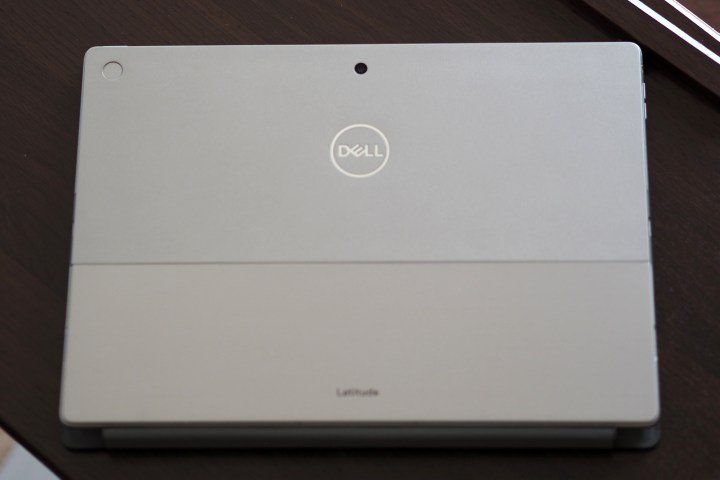
One Latitude 7320 Detachable component that stands out is its webcam. Dell took note of the increased use of videoconferencing thanks to the coronavirus pandemic and built in a 5 megapixel (MP) webcam capable of Full HD (1,920 x 1,080) video at 30 fps. That’s significantly better than the usual 720p laptop webcam and puts the Latitude in a different category as a videoconferencing machine. There’s also a world-facing camera on the back that’s 8MP and can take 1080p video at 30 fps.
Management, security, and privacy
The Latitude 7320 Detachable is available with optional vPro support, which my review unit included. That gives it enhanced manageability and security when connected to a corporate environment. Dell also included several of its optimization features, including ExpressConnect to automatically join the strongest network, Express Response to prioritize the most important apps, and ExpressSign-In. The latter uses an Intel Connect Sensing proximity sensor that can recognize when a user is in front of the tablet and automatically wake it up and lock the tablet when the user steps away.
It’s a nice feature that works well, although it can interfere with long processes — I needed to turn it off to complete our longer benchmarks and to conduct battery testing. There’s also ExpressCharge to deliver a 35% charge in 20 minutes of an 80% charge in an hour, and Intelligent Audio that enhances audio quality and reduces background noise.
Windows 10 Hello support is provided by both an infrared camera and facial recognition and a fingerprint reader located on the back of the chassis close to the power button. If found both to work reliably and quickly, and if you enable facial recognition, then the Latitude 7320 Detachable can automatically recognize you when you return to your workstation and log you straight into Windows.
One thing that’s missing is a way to turn off or obscure the webcam. That’s a common feature on modern laptops and tablets, and it’s missed here.
Battery life

There are 40 watt-hours of battery capacity in the Latitude 7320 Detachable, close to the 42 watt-hours in the ThinkPad X12 Detachable and farther behind the 50 watt-hours in the Surface Pro 7+. With the lower-resolution display and low-power CPU, I was expecting similar battery life to those two machines.
We haven’t tested the Surface Pro 7+, and so I can’t make that comparison. But the Dell outlasted the Lenovo in our tests, starting with the web browsing test where the Latitude 7320 Detachable made it to just over seven hours compared to the ThinkPad X12 Detachable that shut down 12 minutes sooner. That’s not a very strong score, where most modern laptops come closer to 10 hours in this test. In our video test that loops a local Full HD Avengers trailer, the Dell lasted for a stronger 13.5 hours, where the Lenovo just exceeded 11 hours.
In the PCMark 10 Gaming test, which stresses the CPU, the Latitude 7320 Detachable was at the low end of our database at 2.5 hours, where the ThinkPad X12 Detachable managed just 18 minutes more. Finally, in the PCMark 10 Applications test, which is the best indication of likely productivity battery life, the Dell was average at 10.75 hours while the Lenovo lasted for about 30 minutes less.
Overall, these aren’t the best results. You might make it through a day’s work if you keep your tasks light, but stress the CPU at all, and you’ll be looking for the charger. This is common among Windows 10 tablets, though, and so while the Latitude 7320 Detachable can’t compete with larger convertible 2-in-1s and clamshell laptops, it does okay for a Windows 10 tablet.
Our take
The Latitude 7320 Detachable is a fine Windows 10 tablet with features that will appeal to business users. It doesn’t exactly stand out in its performance or battery life, but it’s just as well-built as the competition (except for the kickstand) and offers a good typing and inking experience. It doesn’t beat out the Lenovo ThinkPad X12 Detachable, but it’s a stronger competitor to the Surface Pro 7+.
Really, any of these tablets is a good choice. The Dell should be on your shortlist if you like its feature set, and you probably will.
Are there any alternatives?
The ThinkPad X12 Detachable is the strongest competitor. It’s less expensive than the Dell, and it doesn’t offer quite as many business features. But it’s just as fast and has similar battery life, and its detachable keyboard is more solid.
The Surface Pro 7+ is another alternative tablet, and it’s a great choice if you’re a Surface fan. It’s likely to be slightly faster than the Latitude 7320 Detachable and may offer slightly longer battery life. It, too, is quite expensive and won’t save you any money.
If you’d rather look at a convertible 2-in-1 and don’t care as much about business features, then the HP Spectre x360 14 is a solid competitor. It’s cheaper and better looking, with a spectacular OLED 4K display and a larger 13.5-inch 3:2 panel. It’s larger and heavier and doesn’t work as well as a tablet, but it makes for a better laptop.
The iPad Pro deserves mention, as it continues to add features that make it a stronger competitor to Windows 10 tablets. If you’re bought into the Apple ecosystem, then the iPad Pro should be given strong consideration.
How long will it last?
The Latitude 7320 Detachable is a robust laptop with modern components that should last you years of service. The single year of warranty is disappointing for a business-class machine, but Dell offers several service upgrades.
Should you buy it?
Yes. The Latitude 7320 Detachable has enough features to make it a solid choice for business professionals.
Editors' Recommendations
- 7 best 2-in-1 laptops in 2024: tested and reviewed
- The best laptops for kids, tested and selected by experts
- HP’s new Envy x360 14 looks like a killer value for what you get
- The HP Dragonfly Folio G3 brings back iconic pull-forward design
- The redesigned new Dell XPS 13 2-in-1 officially launches on August 25


